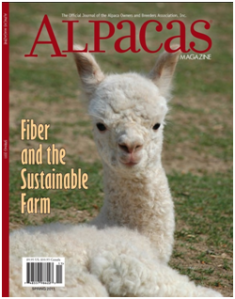Founder Adam Foster Collins, working with past volunteer Carolina Reyes recently had a fascinating article published in the Alpacas Magazine.
 Below we have published the first paragraph, if you would like to read more please Download The Full Article Here Anyone who knows alpacas is likely aware of their long history in South America. A quick overview of that history will tell you that the alpaca appears in the art of the Mochica civilization of northern Peru from over a thousand years ago, and was domesticated long before that. For millennia, alpacas have lived under the protection of human kind and Peru is still home to most of the world’s alpacas. A grass-roots NGO (non-governmental organization) called Threads of Peru is at work with the indigenous Quechua people—descendents of the Inca—in an effort to create sustainable markets for the woven fiber of this treasured animal. A visit to the Sacred Valley with Threads of Peru offers us a rare glimpse of life with the alpaca today.
Below we have published the first paragraph, if you would like to read more please Download The Full Article Here Anyone who knows alpacas is likely aware of their long history in South America. A quick overview of that history will tell you that the alpaca appears in the art of the Mochica civilization of northern Peru from over a thousand years ago, and was domesticated long before that. For millennia, alpacas have lived under the protection of human kind and Peru is still home to most of the world’s alpacas. A grass-roots NGO (non-governmental organization) called Threads of Peru is at work with the indigenous Quechua people—descendents of the Inca—in an effort to create sustainable markets for the woven fiber of this treasured animal. A visit to the Sacred Valley with Threads of Peru offers us a rare glimpse of life with the alpaca today.
The Sacred Valley region of Peru was the center of Inca civilization from the early 13th century until the Incas were conquered by the Spanish, and the alpaca was intimately tied to the Inca culture. The Incas bestowed special religious significance upon the alpaca, sacrificing one at sunrise, noon, and sunset to appease their gods. Because of this special religious importance, the Incas separated their alpacas from other forms of livestock and segregated the herds by color. Alpacas provided the Inca people with clothing, food, and fuel. Material woven from alpaca fleece was prized above gold and silver.
Volunteering Opportunities The co-author of this article (Carolina Reyes) was a volunteer with us and worked with the women in the communities. If this is something that you would be interested in we have diverse range of volunteer opportunities within our organisation. To find out more about our current opportunities please get in touch.



